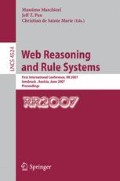Abstract
Expressing rules in controlled natural language can bring us closer to the vision of the Semantic Web since rules can be written in the notation of the application domain and are understandable by anybody. AceRules is a prototype of a rule system with a multi-semantics architecture. It demonstrates the formal representation of rules using the controlled natural language ACE. We show that a rule language can be executable and easily understandable at the same time. AceRules is available via a web service and two web interfaces.
Access this chapter
Tax calculation will be finalised at checkout
Purchases are for personal use only
Preview
Unable to display preview. Download preview PDF.
References
ACE 5 Interpretation Rules. Attempto Documentation (December 13 2006), http://attempto.ifi.uzh.ch/site/docs/ace/_interpretationrules.html
AceRules Webservice. Attempto Documentation (March 15, 2007), http://attempto.ifi.uzh.ch/site/docs/acerules/_webservice.html
Authoring Tools for ACE. Attempto Documentation (March 23, 2007), http://attempto.ifi.uzh.ch/site/docs/authoring/_tools.html
Berners-Lee, T., Hendler, J., Lassila, O.: The semantic web. Scientific American (2001)
Bernstein, A., Kaufmann, E.: GINO - A Guided Input Natural Language Ontology Editor. In: Cruz, I., Decker, S., Allemang, D., Preist, C., Schwabe, D., Mika, P., Uschold, M., Aroyo, L. (eds.) ISWC 2006. LNCS, vol. 4273, pp. 144–157. Springer, Heidelberg (2006)
Dörflinger, M.: Interpreting Courteous Logic Programs, Diploma Thesis. Department of Informatics, University of Zurich (2005)
Fuchs, N.E., Hoefler, S., Kaljurand, K., Kuhn, T., Schneider, G., Schwertel, U.: Discourse Representation Structures for ACE 5, Technical Report ifi-2006.10. Department of Informatics, University of Zurich (2006)
Fuchs, N.E., Kaljurand, K., Schneider, G.: Attempto Controlled English Meets the Challenges of Knowledge Representation, Reasoning, Interoperability and User Interfaces. In: The 19th International FLAIRS Conference (FLAIRS’2006) (2006)
Fuchs, N.E., Schwertel, U., Schwitter, R.: Attempto Controlled English — Not Just Another Logic Specification Language. In: Flener, P. (ed.) LOPSTR 1998. LNCS, vol. 1559, Springer, Heidelberg (1999)
Gelfond, M., Lifschitz, V.: The stable model semantics for logic programming. In: Proceedings of the 5th International Conference on Logic Programming, pp. 1070–1080. MIT Press, Cambridge (1988)
Gelfond, M., Lifschitz, V.: Classical negation in logic programs and disjunctive databases. New Generation Computing 9, 365–385 (1990)
Grosof, B.N.: Courteous Logic Programs: Prioritized Conflict Handling For Rules. IBM Research Report RC 20836. Technical report, IBM T.J. Watson Research Center (1997)
Halpin, T.: Business Rule Verbalization. In: Doroshenko, A., Halpin, T., Liddle, S. W., Mayr, H.C. (eds.) In: Proceedings of Information Systems Technology and its Applications, 3rd International Conference ISTA 2004, Lecture Notes in Informatics (2004)
Halpin, T., Curland, M.: Automated Verbalization for ORM 2. In: Meersman, R., Tari, Z., Herrero, P. (eds.) On the Move to Meaningful Internet Systems 2006: OTM 2006 Workshops. LNCS, vol. 4278, pp. 1181–1190. Springer, Heidelberg (2006)
Hoefler, S.: The Syntax of Attempto Controlled English: An Abstract Grammar for ACE 4.0, Technical Report ifi-2004.03. Department of Informatics, University of Zurich (2004)
Jarrar, M., Keet, M., Dongilli, P.: Multilingual verbalization of ORM conceptual models and axiomatized ontologies. Technical report, Vrije Universiteit Brussel (2006)
Kaljurand, K., Fuchs, N.E.: Bidirectional mapping between OWL DL and Attempto Controlled English. In: Fourth Workshop on Principles and Practice of Semantic Web Reasoning, Budva, Montenegro (2006)
Kaufmann, E., Bernstein, A., Zumstein, R.: Querix: A Natural Language Interface to Query Ontologies Based on Clarification Dialogs. In: 5th International Semantic Web Conference (2006)
Kuhn, T., Royer, L., Fuchs, N.E., Schroeder, M.: Improving Text Mining with Controlled Natural Language: A Case Study for Protein Interactions. In: Leser, U., Naumann, F., Eckman, B. (eds.) DILS 2006. LNCS (LNBI), vol. 4075, Springer, Heidelberg (2006)
Lukichev, S., Wagner, G.: Verbalization of the REWERSE I1 Rule Markup Language, Deliverable I1-D6. Technical report, REWERSE (2006)
Niemelä, I., Simons, P.: Smodels — an implementation of the stable model and well-founded semantics for normal logic programs. In: Fuhrbach, U., Dix, J., Nerode, A. (eds.) LPNMR 1997. LNCS, vol. 1265, pp. 420–429. Springer, Heidelberg (1997)
Nute, D.: Defeasible Logic. In: Handbook of Logic in Artificial Intelligence and Logic Programming. Nonmonotonic Reasoning and Uncertain Reasoning, vol. 3, pp. 353–395. Oxford University Press, Oxford (1994)
Przymusinski, T.C.: Stable Semantics for Disjunctive Programs. New Generation Computing 9(3/4), 401–424 (1991)
Schwitter, R., Ljungberg, A., Hood, D.: ECOLE: A Look-ahead Editor for a Controlled Language. In: Proceedings of EAMT-CLAW03, Controlled Language Translation, Dublin City University, pp. 141–150 (2003)
Syrjänen, T.: Lparse 1.0 User’s Manual (2000)
Thompson, C.W., Pazandak, P., Tennant, H.R.: Talk to Your Semantic Web. IEEE Internet Computing 9(6), 75–79 (2005)
Wagner, G.: Web Rules Need Two Kinds of Negation. In: Bry, F., Henze, N., Małuszyński, J. (eds.) PPSWR 2003. LNCS, vol. 2901, pp. 33–50. Springer, Heidelberg (2003)
Author information
Authors and Affiliations
Editor information
Rights and permissions
Copyright information
© 2007 Springer Berlin Heidelberg
About this paper
Cite this paper
Kuhn, T. (2007). AceRules: Executing Rules in Controlled Natural Language. In: Marchiori, M., Pan, J.Z., Marie, C.d.S. (eds) Web Reasoning and Rule Systems. RR 2007. Lecture Notes in Computer Science, vol 4524. Springer, Berlin, Heidelberg. https://doi.org/10.1007/978-3-540-72982-2_24
Download citation
DOI: https://doi.org/10.1007/978-3-540-72982-2_24
Publisher Name: Springer, Berlin, Heidelberg
Print ISBN: 978-3-540-72981-5
Online ISBN: 978-3-540-72982-2
eBook Packages: Computer ScienceComputer Science (R0)

